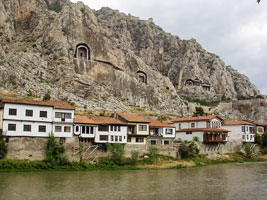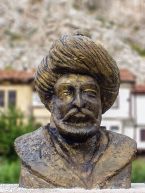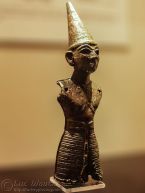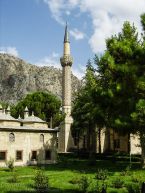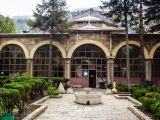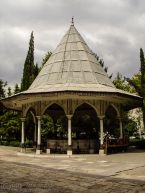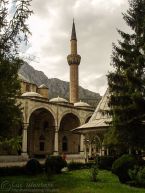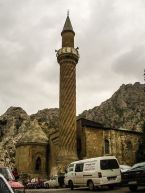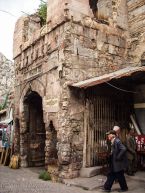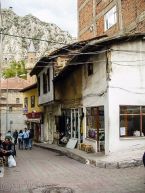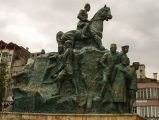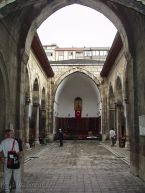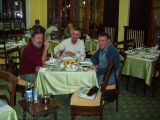Coming from, or going to the Black Sea, Amasya always offers a pleasant stop. It is one of Turkey's most beautiful cities, stretching along the banks of the Yeşilırmak (Green River, in antiquity known as the Iris River) in a narrow ravine, with sheer rock cliffs rising above the town centre. The river is crossed by six bridges within the city, the oldest of them, dates back to 1122.
History of Amasya
Amasya has a history of 7,500 years, and it is proud of it. Amaseia or Amasia, as it was called in antiquity, has roots dating back to the Hittite Empire. From 323 BC until 183 BC it was the capital of the Pontic Kingdom. As a remnant of this golden age, the impressive rock tombs of the Pontic kings, the Kral Kaya Mezarları, still dominate the city. The tombs are illuminated at night, which contributes much to Amasya's attraction.
In 63 BC, Strabo, the ancient historian, and geographer and Amasya's most famous citizen, was born here. After about 1000 years of Byzantine rule, the Turkish Seljuks and Mongols conquered the town and left many fine buildings, of which many are still present today. Amasya was conquered by the Ottoman Sultan Bayezid I in 1392 and became a major city in the Ottoman Empire. Many Ottoman crown princes (şehzade) were taught statecraft in Amasya and were tested for their skill by being governor of the province. Amasya was also important as a centre for Islamic theological studies with 18 medreses and one külliye. European travellers used to refer to Amasya as the Oxford of Anatolia.
Sights and Photos
We start our tour of the city at the south bank of the Yeşilırmak river and admire the beautiful Ottoman houses and the scenic rock tombs of the Pontic kings on the opposite shore. Busts of several Ottoman sultans and other famous citizens of Amasya, like Strabo who was born here, line the riverfront. Amasya played an important role in the education of the young sultans, the princes or şehzade were sent to Amasya to govern the Vilayet (province) and thereby gain experience. The most famous student prince was certainly Fatih Sultan Mehmet II, the conqueror of Constantinople. At the age of six, he was governor of Amasya for one year in 1438.
We now leave the area near the river and head more south where we first visit the Gök Medrese Camii or Mosque of the Blue Seminary, which was founded in 1266-1267 by Emir Seyfettin Torumtay, a slave of the Seljuk Sultan Keykubad II, who became governor of Amasya. As is pointed out by its name, the mosque served as a medrese. The dome of the mosque was once covered with blue (gök) tiles, a few of which are still present. Next, we visit the Kadılar Türbesi or tomb of the Muslim judges. This is one of the Eyvan type tombs which belonged to the former judges (Kadıs) of Amasya. It was built in the 15th Century. As is shown by Greek inscriptions on a stone nearby the tomb, recycling of antiques as building materials was common practice.
Our next stop is the archaeological museum where the famous statuette of Amasya, a bronze figure of the Hittite storm god Teshub is on display. The yard of the museum houses the tomb of the Seljuk Sultan Mesud I (1116–1156). Inside the tomb, in the Hall of Mummies, the remains of the Ilkhan rulers of Amasya are on display. The Ilkhans were the successors of Genghis Khan who had defeated the Seljuks. The mummies belong to the son of Anatolian Minister Sultan Cumudar, Amir of Amasya Işbuğa Nuyin, Izzettin Mehmet Pervane, his wife, sons, and daughters. The process of mummification in Turkey was completely different from that in Egypt. According to Mr Muzaffer Doğanbaş, a researcher at the Amasya Museum, nearly 40 chemicals and medicines were used in Turkish mummification.
Here are the photos of the first part of our tour through Amasya, click on the thumbnails to see greater pictures.
https://turkeyphotoguide.com/amasya?tmpl=component&print=1&layout=default#sigProId3f41da21e6
Our tour continues with a visit to the Sultan Beyazit II Külliye constructed in 1485-1486. A külliye is a kind of religious centre and is composed of a mosque, a theology school, charitable establishment, monument and şadırvan (i.e. water tank with a fountain).
Further, on the south bank of the Yeşilırmak, there is the Burmalı Minare Camii or Spiral Minaret Mosque, which is also of Seljuk origin and was built between 1237 and 1247 by Necmettin Ferruh Bey, one of the Seljuk Emirs to Sultan Keyhusrev. During the Ottoman period, it was restored in 1590 after an earthquake and following a fire in 1602 when the original wooden minaret was replaced by the current stone structure with its elegant spiral carving.
Next, we visit the Taş Han, a 17th century Ottoman Caravanserai. When we visited Amasya in 2003, the Taş Han was badly ruined. In the meantime, it has been restored (2011-2012) and turned into a luxury hotel (Tashan Hotel). According to some sources the hanVakıf Bedesten Kapalı Çarşı. A bedesten is a vaulted fireproof market enclosure where valuable goods are kept. The Amasya Bedesten was built in 1483 by the Janissary guard of Sultan Bayezid II. The term Vakıf means that it is a donation from individuals to the community.
Here are the photos of the second part of our tour, click on the thumbnails to see greater pictures.
https://turkeyphotoguide.com/amasya?tmpl=component&print=1&layout=default#sigProId470d4573d1
On June 22, 1919, Mustafa Kemal Atatürk issued the Amasya Declaration regarding the need for national resistance against the invasion of foreign powers, which was the actual starting point of the Turkish War of Independence. This pivotal event is commemorated by the impressive monument at Atatürk Meydanı.
The Bimarhane Medresesi was built by Amber Bin Abdullah for Iduş Hatun, the wife of the Mongolian Ilkhanid Sultan Oljaytu in 1309 as an asylum for the mentally ill. It is the first known mental hospital and is a typical example of how the Mongols adopted the architectural styles of their subjects, as the hospital was built like a Seljuk medrese. The building was also called Timarhane (House of Correct Treatment) or Darüşşifa (House of Healing). In the Bimarhane, the sound of water and music was used as a therapy for mental patients. It is interesting to know that the Bimarhane housed the town's conservatory between 1999 and 2011. Now it has been restored as a medicine museum, named after Şerefeddin Sabuncuoğlu (1385-1468), a famous Ottoman surgeon and physician from Amasya who worked for 14 years in the Bimarhane. He was the author of the first illustrated surgical atlas, the Cerrahiyyetu'l-Haniyye (Imperial Surgery). The portal of the Bimarhane reflects the classical Seljukian architecture and is a beautiful example of Seljukian craftsmanship.
The Mehmet Paşa Camii dates from 1486 and was commissioned by Mehmet Paşa, the tutor of Prince Ahmet, son of Sultan Bayezid II. Inside there is a finely decorated marble pulpit.
The Gümüşlü Cami or Silvery Mosque is Amasya's earliest Ottoman mosque. Originally built in 1326, it was rebuilt after an earthquake in 1491, originally built in 1326, again in 1612 and once more in 1688. The final restoration was in 1988.
From 323 BC until 183 BC, Amasya was the capital of the Pontic Kingdom. As a remnant of this golden age, the impressive rock tombs of the Pontic kings still dominate the city. The tombs are illuminated at night, which contributes much to Amasya's attraction. The Palace of the Maidens was the seat of the Palace of the Pontic Kings, of which the most famous was undoubtedly Mithridates the Great. In later times the Seljuks used it as an arsenal. From the tombs, the panoramic view on Amasya and its dramatic setting makes the climb more than worthwhile.
Back in town, we visit the Beyazit Paşa Camii, with its coloured marble arches of the porch, was finished in 1419 and is an example of early Ottoman architecture. The main bridge Hükümet Köprüsü is opposite the main square. Next to the clock tower is the Amasya Şehir Derneği, a quasi-private club. Nevertheless, foreign tourists are more than welcome here to join Amasya's prominent citizens in drinking and eating.
Here are the photos of the final part of our tour, click on the thumbnails to see greater pictures.
https://turkeyphotoguide.com/amasya?tmpl=component&print=1&layout=default#sigProId56c50b1d4f
Travel Information & Travel Tips
Coming from Samsun, we spent two nights in Hotel Maden (Dere Mah. Mustafa Kemal Paşa Cad. 5, Tel. 03582129559), a clean and comfortable place.
